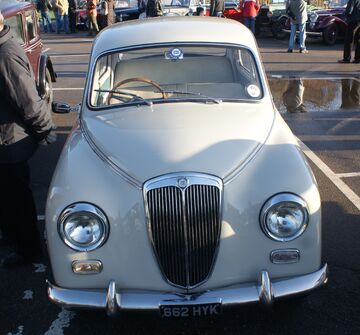
Lancia Appia
Lancia Appia was a car introduced in 1953 as a replacement for the Ardea and in production for 10 years. The Appia was the last in a long line of Lancia production cars dating back to the Lancia Lambda (introduced in 1922) to use the famous sliding pillar front suspension. All three series produced had a V4 engine of 1089 cc, which gave the car good performance.
In addition to the saloons, a number of special bodied Appias were produced, including a Coupe, by Pininfarina, a convertible by Vignale and an aluminium bodied GT by Zagato.
The Appia was renowned for its high quality and simple engineering refinement, which helped it gain a deserved reputation for reliability and longevity.
Often overlooked by classic car enthusiasts (and the press) in favour of its more prestigious stable mates the Aurelia and Flaminia, those who own and run these cars know that they are equally deserving of recognition and preservation.
Three series of Appia was built:
- 1st series, produced between 1953 and 1956. Only sedan (Berlina) body style built, similar style to the Aurelia.
- 2nd series, produced between 1956 and 1959. Longer wheelbase, different boot and higher engine power.
More sportier 2-door version was also available.
- 3rd series, produced between 1959 and 1963. New front end with new new horizontal grille and lower bonnet line and more engine power.
Approximately 98,000 Appias were built as Berlinas, 3,900 as commercial vehicles and 5,200 supplied to coachbuilders.
Styles and Major Options[]
C10[]
Sedan-version C10 was introduced in April 1953 at the Turin Motor Show. The body style was similar to the sister model Aurelia. At the Geneva Motor Show in March 1956 the second series was introduced with 3 centimetres (1.2 in) longer wheelbase and a modernized body. In March 1959 the third series was introduced at the Geneva Motor Show with new front end, inspired by the Flaminia. Between 1960 and 1962 a three door estate version was built by Viotto, it was called as Giardinetta.
Commercial variants[]
Lancia also built light commercial bodies on the Appia chassis: the Furgoncino (Van), Camioncino (pick-up) and an ambulance version the Autolettiga.
Coupé[]
Pininfarina built a coupé version between 1957 and 1963.
Cabriolet/Berlina Lusso[]
Vignale built a cabriolet version between 1957 and 1963. Between 1959 and 1961 the Berlina Lusso was also available with styling cues from the cabriolet.
GT/GTS/GTE[]
Zagato built many coupé versions based on the Berlina between 1957 and 1962.
- GT same engine as Pininfarina and Vignales models.
- GTS more powerful engine, 2-door version
- GTE had modified body
Sport[]
Zagato built around 750 cars on the Appia chassis.
Engine and Transmission[]
The Appia has V4-engine with 10,2° valve angle and one cylinderhead for both cylinder blocks.
| Model | Production years | Engine | Displacement | Power | Fuel system |
|---|---|---|---|---|---|
| Berlina S.I | 1953-56 | V4 SOHC | 1089 cc | 38 hp | Single carburetor |
| Berlina S.II | 1956-59 | V4 SOHC | 1089 cc | 43 hp | Single carburetor |
| Berlina S.III | 1959-63 | V4 SOHC | 1089 cc | 48 hp | Single carburetor |
| Coupé, Cabrio | 1956-63 | V4 SOHC | 1089 cc | 53 hp | Single carburetor |
| GTS | 1956-58 | V4 SOHC | 1089 cc | 58 hp | Single carburetor |
| Sport | 1960-63 | V4 SOHC | 1089 cc | 60 hp | Single carburetor |
Performance[]
An S1 Berlina saloon tested by the British The Motor magazine in 1954 had a top speed of 76.1 mph (122.5 km/h) and could accelerate from 0-60 mph (97 km/h) in 32.5 seconds. A fuel consumption of (9.74 L/100 km/24.1 mpg-US) was recorded. The car was not at the time available on the UK market but an Italian price of 1,328,600 Lire was reported (converted to £780).




